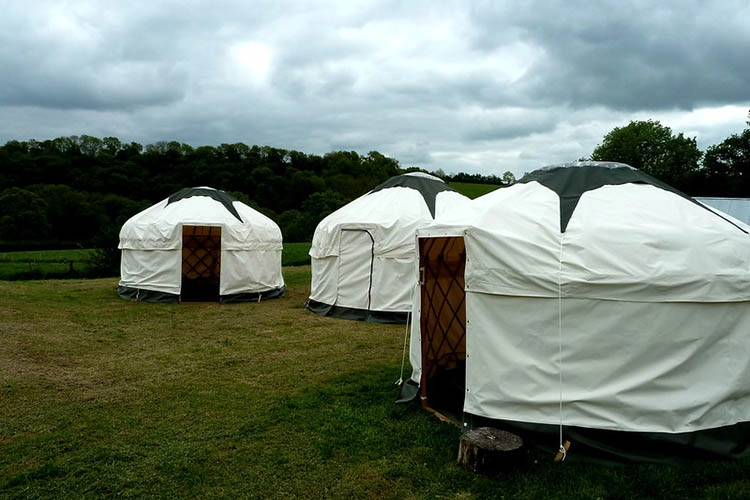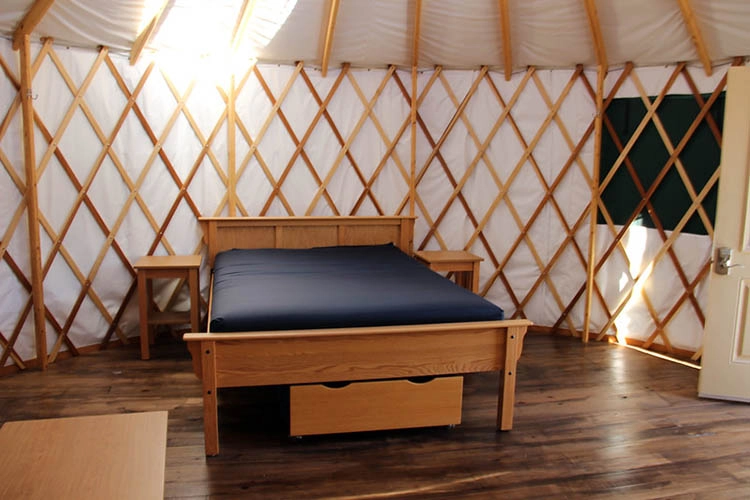History Of Yurts
The original yurts didn’t look much different from a miniature circus tent – they were traditionally white with red trim and a red door. You may conjure up an image from history books of Ghengis Khan standing outside a yurt which was the preferred living quarters of the nomadic peoples of Central Asia. In fact, 90 percent of those living in rural Mongolia still live in yurts. These structures were originally created to be easily transported from one place to another for nomadic cultures. Yet, the construction was amazingly strong and withstood extreme temperatures and wind.
Today, yurts are popular for people looking for alternatives to the high cost of owning a home or vacation home. They’re also popular for creating additional living spaces at cabins that have some extra land. They are more affordable and relatively easy to build than a guest cabin.
While today’s modern yurts can be as simple as traditional ones, they have evolved since their origins and can be quite luxurious. Modern yurts range from simple structures that closely mimic historical design to more elaborate structures that include all the amenities we expect in our modern homes including plumbing, electricity, and other conveniences. They have become popular structures for glamping as they provide a unique but comfortable experience in the outdoors.
Reasons to Build a Yurt
Yurts have many uses including a guest house, a temporary home while you are building your dream cabin, a base camp for adventures on recreational land, to generate rental income, or even as a home office.
Yurts have also been used to create a backyard spa – as an enclosure for a hot tub to provide protection from the elements. It can also be used for yoga, fitness, or a meditation space on your property. They also make great artists’ studios as they are more affordable than building a separate structure but provide peace and quiet.
Some people are turning to yurts for full-time accommodation as an eco-friendly and budget-friendly alternative to the high cost of owning a home. Glamping sites like Under Canvas and Glamping Hub provide vacation rentals in yurts if you want to try the experience before committing.
Do Yurts Require a Building Permit?
Yurts are considered a temporary structure in most instances unless it is built on a foundation, in which case it may be considered permanent.
Whether a yurt is considered temporary or permanent depends on the building codes in your area. If you are planning to build a yurt, check with your local building codes on whether you need a permit and any other regulations that apply.
Inside the city limits, there may be additional restrictions on how long a yurt can be used continuously. Regulations vary not only from state to state but also from one county or city to another. So take the time to research the code in your chosen area thoroughly before finalizing your decision. This will save both time and money down the road.
View this post on Instagram
What is a Yurt Made Of?
Traditional yurts were made of a wooden frame woven into a lattice shape. The frame was separated for easy transportation and tied together with animal hair or rope. The roof of a yurt starts with a ring to which a number of poles are attached in a sunrise pattern. These poles were bound together with animal hair or rope and are further stabilized by an elastic-type band woven around the top. A hole at the top, where the ring is located, allows venting from the heat source. Some yurts have an additional partial dome attached to this ring to allow smoke to exit but protect the inside from rain or snow. Once the frame is made, the entire structure is covered with several layers of insulation material. Traditionally, felt material made from wool or yak hair was used.
Today, yurts are made with contemporary materials although wooden lattice walls, straight rafters, and tensions bands are still key features of its construction. Modern yurts have a central ring with an acrylic dome skylight and might also include windows. The door might be a basic wooden door or an upgrade could be french doors.
In place of felt material, durable high-tech fabric covers the yurt which makes it long-lasting and able to withstand the elements. Many forms of insulation can be used in a modern yurt from wood stoves to radiant floor heating.
Can Yurts Be Heated?
Yes, yurts can be heated. Many are heated with a propane, wood or pellet stove that is placed in the center of the large, main room. A chimney is then created. This runs upward and allows the smoke from the stove to be vented out of the wall or the hole in the roof.
If your yurt has electricity, it is possible to use space heaters or a portable fireplace for warmth.
Adding a solar panel to your yurt is another way to keep it warm depending on where you live and how much solar gain you can expect.
Some yurts are even equipped with radiant floor heating which allows the warmth to come up from the floors and rise to the top.
View this post on Instagram
Upgrades to your Yurt
Modern yurts can include bathrooms, kitchens, and additional living space. Some designs include a lofted space or even a second story. A popular addition to any yurt is a larger deck for outdoor living.
While outdoor bathrooms and showers are most common for yurts, an indoor bathroom is also possible. Composting toilets are the most popular choice as they don’t require a septic system or water hookups. These toilets use a natural process of decomposition to transform waste.
If your site has access to a sewer or septic system, plumbing can be installed underneath the platform of the yurt for a modern bathroom.
Some properties will utilize adjoining yurts to create a separate bathhouse.
While basic yurts will not come with electricity, it is possible to add electrical wiring – typically through the platform floor. If electrical service is not available at the site, solar or propane systems can also be used for lighting and heating.
Things to Consider Before Buying or Building a Yurt
A yurt can be a great alternative or addition to your cabin. But you’ll want to consider the pros and cons of a yurt before buying or building one.
PROS
- Staying in a yurt can be a wonderfully unique experience
- Budget-friendly compared to the cost of building a home or additional structure
- In addition to lower cost to build, more budget-friendly for heating, cooling and maintaining
- Eco-friendly – they use less building materials, use a smaller footprint and blend into the outdoor environment
- Simpler Lifestyle – staying in a yurt, whether it’s for a week or a whole summer, lends itself to a simple life with less stuff and more time spent outdoors
- Portable – you can pick up and move a yurt unlike a permanent structure
CONS
- Open Plan – the design doesn’t lend itself to a lot of privacy
- Space – living space and storage options may feel limited depending on your needs
- Heating and Cooling – while there are options to efficiently heat and cool your yurt, you may find it harder to maintain a comfortable temperature due to the dome structure
- Weather – while modern yurts are made to withstand the elements, you might be more aware of rain, wind, and snow beating down on a yurt
Sleeping in a yurt can be a memorable experience – whether it’s for a vacation home, a guest house, or a full-time experience. But there are things to consider before investing in this unique structure.
They are popular for adventurous folks and many yurt dwellers enjoy the unique home that brings them closer to nature and provides a simpler, more affordable lifestyle.
If the idea of a yurt is interesting to you, you can try one out as a vacation experience -there are many for rent on sites like Glamping Hub, Airbnb or VRBO. You can try one out before making the investment and see for yourself why yurts have been gaining in popularity.


